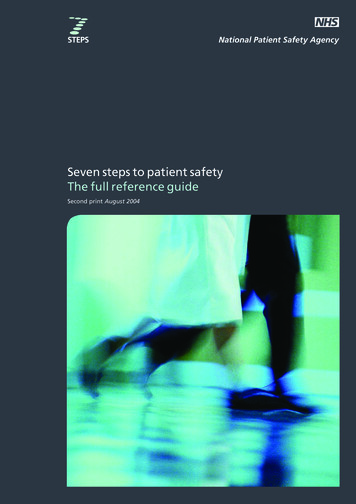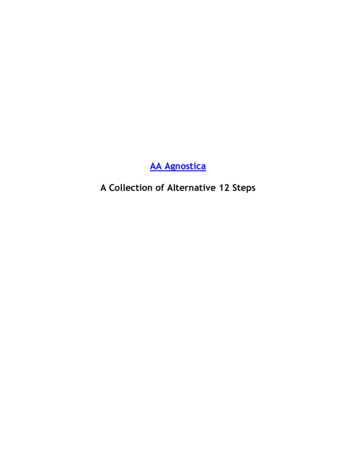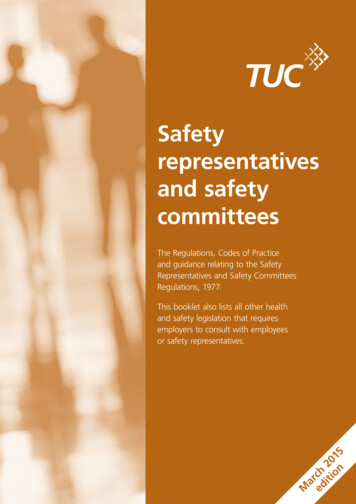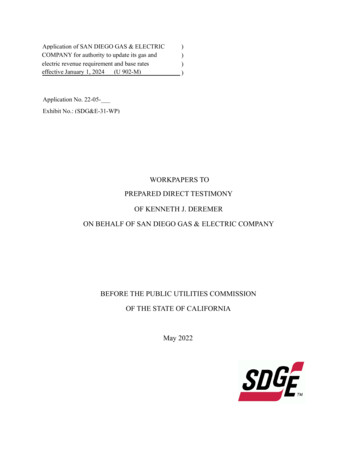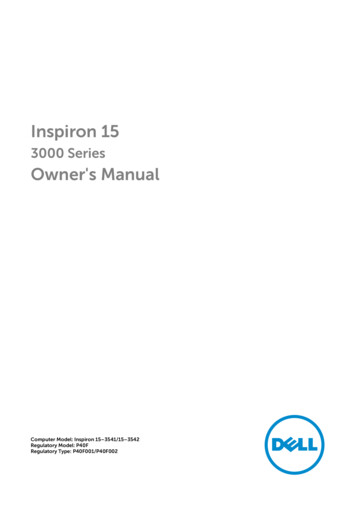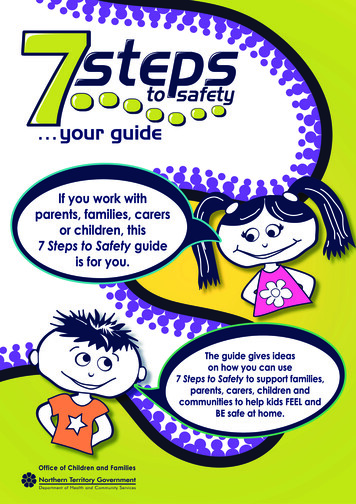
Transcription
Contents1. Why a 7 Steps to Safety GUIDE?32. Why a 7 Steps to Safety KIT?33. Further development of the kit44. Each Step in 7 Steps to Safety includes 55. Printing out the Steps66. Using the kit with different groupsIndividual families; parent groups; groups of children; communities and community groups77. Your guide to using each StepStep 1: Make Your Place Safe10Step 2: Cool Tools for Family Rules13Step 3: Feel Safe with People19Step 4: What’s Special about Our Family?26Step 5: Emergency29Step 6: Ready Yet?35Step 7: Make a Care Plan418. Resource List449. Your feedback:An invitation to provide feedback about how the guide has worked for you45 Northern Territory Government, DHCS 2006. This resource may be downloaded, printed or photocopied fornon-commercial purposes in the current format only. All enquiries should be directed to Manager, Office ofChildren and Families, Department of Health and Community Services (DHCS), Northern Territory GovernmentAUSTRALIA. Telephone within Australia: 1800 005 485 or email families@nt.gov.au7 Steps to Safety was developed in consultation with Northern Territory parents, children and service providersand from current Australian and overseas literature. Kit and guide developed by Meron Looney, ProjectWorker, “Family Safety Plan Kit”.7 Steps to Safety aims to promote the safety and wellbeing of children. Material contained in the kit isintended for information purposes and cannot be taken as legal or medical advice.A free copy of the 7 Steps to Safety resource kit can be downloaded at http://www.families.nt.gov.auA guide to usingwith families, children and communities
Why a 7 Steps to SafetyGUIDE?This 7 Steps to Safety GUIDE is for people who want touse the 7 Steps to Safety KIT in their work with parents,families, carers, children or communities.The purpose of the guide is to outline how the 7 Steps to Safety kit can be used topromote discussion and activity focussing on the safety of children in the home andfamily environment. People who work with families and children - such as familysupport workers, teachers, neighbourhood centre coordinators, health workers andpolice - or people who work with communities or community groups can use the guide,which has been developed by the Northern Territory Government’s Office of Childrenand Families.You can use 7 Steps to Safety to assist any family to prepare and plan for the safety oftheir children as they grow up and become more independent. Some of you, however,may work with families facing particular challenges such as violence or substanceabuse. Some families may have a member with a physical illness or disability or amental health issue. In other families, a child could be at risk of harm or neglect. In anyof these situations, the kit can be used to raise and explore a number of sensitive issuesrelated to children’s physical and emotional safety.This guide gives you just a few suggestions about how you can use 7 Steps to Safety inyour work with families. Be creative! Your experience will no doubt generate manymore ideas about how you can use the kit to enhance and promote the safety andwellbeing of children.Why a 7 Steps to SafetyKIT?The idea to develop a family safety plan resource originatedfrom people working with families whose circumstancesplaced their children at significant risk of harm. Workerssaw a need for an evidence-based, standardised resourcethat could give greater consistency to safety planning andbe adapted to meet specific risk needs of individualfamilies. The Office of Children and Families subsequentlytook on the role to develop a Family Safety Plan Kit.The process for developing the kit included research of Australian and overseasliterature; consultations and focus groups with children, families and family-focussedservice providers; and a trial of the kit in its draft form. The result of this process is the7 Steps to Safety kit.A guide to usingwith families, children and communities3
7 Steps to Safety provides information, activities and tips to help families identifycircumstances that could place children at risk of harm and to develop strategies toprevent or deal with risky situations. It aims to build resilience in children by helpingthem to gain skills and confidence in their ability to make decisions in a range ofsituations. It also aims to build on family strengths and to provide opportunities forfamilies to work together in creating safe and positive environments for children.The kit can be used by people in their work with vulnerable families, or by familiesindependent of professional support. It is designed for use with children of any age, butmay be particularly useful for families with children from preschool to teenage years.Each ‘Step’ in the kit focuses on a different area associated with safety for children athome.The seven steps to safety are:Step 1:Make Your Place SafeStep 2:Cool Tools for Family RulesStep 3:Feel Safe with PeopleStep 4:What’s Special about Our Family?Step 5:EmergencyStep 6:Ready Yet?Step 7:Make a Care PlanFurther development of the kitAlthough designed for all Northern Territory families, 7 Steps to Safety has not beenspecifically trialed with families from culturally diverse backgrounds. The Office ofChildren and Families is keen to hear from people who have used the kit in a range ofapplications, with particular interest in how it might be further developed to meet theneeds of people living in remote communities. Details about how you can providefeedback about the 7 Steps to Safety kit, along with an evaluation form about this guide,are provided on page 45.Please let us know of any ideas you have tried and would like to share with others.A guide to usingwith families, children and communities4
Each Step in 7 Steps to Safetyincludes:Each 7 Steps to Safety Step includes a number of elements. These are designed toprovide families with information they can use to create safe family environments andbuild on each child’s capacity to make safe decisions in challenging or potentiallyunsafe situations.Each Step has comments from childrenThese are real statements from realchildren. They were acquired duringschool-based workshops with children andthrough more casual chats throughout thedevelopment of the kit.As parents, carers and professionals we make decisions ‘for’ and ‘about’ children all thetime, without always considering the impact of these decisions. Some of the statementsin ‘What Territory Kids Say ’ offer a powerful reminder of how our decisions canaffect children. As children talked about their experiences and the things that worriedthem and made them feel safe or unsafe, their responses served to focus the kit on issuesthat were of genuine importance to children. Their statements give an insight into howchildren feel and what they think about a range of issues that can affect their safety andwellbeing. They can also be used to give a true voice to children and their experiences,even when children are not physically present. The statements from “What TerritoryKids Say ” and copies of the children’s drawings in the kit can be used to make flashcards and prompt discussion.Each Step asksThese sections provide the rationale as to why it is important to consider the issuescovered in each Step. They are founded on research as well as on the experiences ofparents and children and those who work with them.Each Step has Parent TipsThe Parent Tips have been drawn from research, parents’experiences and input from people who work in a rangeof fields involved in community safety and children’sphysical, social, emotional and psychological safety andwell-being. They provide practical ideas and guidelines to helpfamilies enhance the physical and emotional safety of theirchildren, with a goal to increasing children’s capacity to thinkand act safely. It’s important to remember that parents willalready have their own stories to tell and valuable tips forhelping to work things out.A guide to usingwith families, children and communities5
Most Steps have a StoryThe stories explore common dilemmas for children andgive examples of how children might think, feel andreact in certain situations. They show families how theycan use the information in the kit, along with familydiscussions and activities, to help create a homeenvironment where children can feel and be safe.Most Steps have a Family ActivityA strong family has family members who communicateopenly and honestly, who listen to and respect eachother and who sort out problems together. Childrenfrom supportive families who communicate in positiveways with each other are more likely to develop asecure sense of belonging and the self-esteem,confidence and self-control they need to make decisionsindependently and safely. Children also learn best by‘doing’ – by being actively involved and havingopportunities to practise what they learn.The ‘Family Activities’ in 7 Steps to Safety build on these factors to provideopportunities for families to work together in fun, practical ways to increase the abilityand confidence of children to stay, and feel, safe. Four of the “Family Activities”provide guidelines for families to make their own Safety and Emergency Plans:Step 2:Make Your Family RulesStep 3:Make a Helper PlanStep 5:Make an Emergency Contacts ListStep 7:Make a Care PlanPrinting out the StepsFeel free to print out copies of each Step, or of any activities or safety plans you wish touse with parents. If you like, you can use the patterns and page numbers to help youjoin the pages of each Step, from left to right. You’ll end up with a long strip of pagesfor each Step that can be folded up, concertina style. It can be fun for children to help!When working with families you can use all or parts of the Steps and adapt them to suitparticular cultural and social needs.A guide to usingwith families, children and communities6
Using the kit with different groupsIndividualfamiliesparents or carersParentGroups ofgroupschildrenCommunitiesThis section gives a broad outline of how 7 Steps to Safety can be used with differentgroups of people. A more detailed guide to each Step is provided in section 7: “YourGuide to Using Each Step” (page 10). Remember that families are not alone in effectingor planning for children’s safety and wellbeing. You can help families to keep in mindthe many other individuals, groups, neighbours or services they can draw upon in theirplans to help children be, and feel, safe.It’s important that we know how effective the kit is in supporting families. If you wouldlike to contribute to evaluating how useful the kit is for families, pre- and post- testingtools for use in individual counselling or groupwork are available from the Office ofChildren and Families: 1800 005 485.Working with individualfamiliesparents or carersIf you are working with individualfamilies, parents or carers, 7 Steps to Safety can be used as:A general resource to build on existing family strengthsA more specific tool to assist families facing particular issues that could affectchildren’s safety and wellbeing. (For example, if parents are looking for help insetting boundaries with their children, you could take a look at ‘Step 2: Cool Toolsfor Family Rules’ with them.)Some parents might prefer to look through a Step alone and then ask you questions ortalk about issues and strategies if necessary. Others might be better supported inunderstanding the concepts and activities if you go through a Step with them, talkingabout it along the way. You can then help them explore ways to use the information andactivities from the Step with their children, and support them if required.A guide to usingwith families, children and communities7
Whether you are handing out the kit to parents or working through it with them, pleaseconsider the following points:Parents do not need to read through entire Steps with their children. The Steps workbest if parents have an understanding of the issues and then use the parts that arerelevant to their children and situation. Younger children might not be ready forsome of the activities or concepts. It may also be too overwhelming for somechildren to go through all activities or all Steps in quick succession. It may be easierfor them to follow and digest if broken up into ‘manageable’ and relevant pieces.Encourage parents to choose the scenarios in the activities that apply to their owncircumstances and to think up others that are relevant to their family’s situation.You can use your discussions about the kit with parents as a way to help themidentify their specific areas of concern and to explore any underlying issues, valuesor beliefs.You can give families Steps or pages from the kit so they can ‘Try it out!’ at home.(They could talk to you later about how it went.)Encourage parents to use their own words when they talk with their children aboutthe issues in the kit. This will help children to understand and relate to the issues.You can use the kit to help parents identify things they are already doing to build asafe family environment and strong relationships with their children. This isespecially important if parents are feeling overwhelmed.Working with parentgroupsThere are two main ways you can use 7 Steps to Safety to generate discussion ingroups run with parents:As a basis for seven individual sessions that cover a range of children’s safety issues.To elaborate or extend on your existing work with parent groups through usingactivities or sections from the kit.A benefit of exploring the issues from 7 Steps to Safety in a group setting like this is theenormous potential for parents to learn from each other and to recognise that they arenot alone in experiencing the struggles and delights of parenting. Parents can also usethe information in the kit to help them raise public awareness of the rights and needs ofchildren and families in regard to physical and emotional safety. Once again, it’simportant to recognise and draw on the experience and strengths of parents.If you need to know more about running groups and ways to conduct group activities, abasic resource list is provided at the end of this guide. You can also visit your localpublic or university library, or check out the Internet. Where the guide suggests ‘Try itout!’ and parents practise an activity at home, remember to discuss how this went withgroup members at the beginning of the following session. The section “Your Guide toUsing Each Step” (page 10) offers more specific ways that you can use 7 Steps to Safetywith groups of parents.A guide to usingwith families, children and communities8
Working with groups ofchildrenIf you work with children, this guide will offer a rangeof ways you can use the Steps, stories and activities in the 7 Steps to Safety kit.Most of the ideas for group discussions and activities are for primary aged children (sayfive years and over). However the ideas and activities can be easily adapted for older oryounger children. Teachers, Out of School Hours Care coordinators and facilitators ofclubs for children can use 7 Steps to Safety to create a comprehensive program aimed atenhancing children’s capacity to make informed and safe decisions. Alternatively, youcan use individual activities and sections of the kit to supplement existing areas of workor activity.For some of you, 7 Steps to Safety may provide opportunities for children with differentskills or from differing age groups to work together to explore some of the issuescovered in the kit. For example, secondary school media studies or drama studentscould explore some of the issues in the kit with primary school students, who could thenact out skits designed to raise safety-focussed issues. The older students could thenrecord these to produce audio-visual productions that could be used to facilitate furtherdiscussion in the classroom.Please be aware that some activities have the potential to raise uncomfortable feelings insome children or may lead to a disclosure of past or present harm. It’s good practice tobe prepared for how to support a child in this case. Make sure you know the procedurefor making a notification of suspected current child abuse to Family and Children’sServices (FACS). Also, have a list of services or people who could offer support tochildren if necessary.If you are going to use the kit with groups of children (in schools or clubs, for example),it’s good practice to inform parents beforehand. This can also provide a goodopportunity to promote or introduce the kit to families.Working withcommunitiesThe ideas in this guide offer just a few waysyou can use 7 Steps to Safety with communities. A community can be any group ofpeople who call themselves a ‘community’. This can include neighbourhoods, sportingclubs, businesses and workplaces, cultural groups, religious groups, schools, socialgroups, friends, professional groups, internet groups, interest groups or whole towns.As a professional or as a member of a community, you can use 7 Steps to Safety to raiseissues about children’s safety and wellbeing or to add to existing knowledge andunderstanding of group members or the broader community. You could use each Step torun a community forum and invite guest speakers to talk to the topic. Or you couldorganise a family safety event and use the information in the kit to promote issues thatare of concern to community members. Think about different ways you might be able touse the information in the kit to promote children’s safety and wellbeing through, forexample, preparing items for community newsletters such as Neighbourhood Watch orthe local school, or for community radio. Are there other ways of presenting the kit thatmight make it more ‘accessible’ to families (e.g. through an audio-visual production)?A guide to usingwith families, children and communities9
Your guide to using Step 1Step 1Make Your Place SafeStep 1 takes a look at some of thephysical risks to children aroundthe home and provides some tipson how parents can minimise thepotential for harm. It also outlinesa fire safety plan families canpractise together.The goals of Step 1 are:For families and carers to:Have access to information that can help create a safe physical environment for theirchildrenLearn a fun way to practise a home fire-safety drillTips for working with individualfamiliesparents or carersHere are some ideas on how you can useStep 1 with individual families.Help families to identify the things they have already done at home to minimise therisk of harm to their children.Use the kit to help families identify areas or equipment that might not be safe attheir place.Are there any things about their children that could increase the risk to their safety?These could include things like a child’s chronological or developmental age or theirpersonality – are they adventurous, a risk-taker, curious about how things work?What might families need to change around their place to make it safer for theirchildren? How can they do this?Encourage families to practise the Family Activity ‘Get your family together andpretend there is a fire in your home’. Discuss any issues or concerns.A guide to usingwith families, children and communities10
Your guide to using Step 1Tips for working with parentgroupsHere are some suggestions of how you could useStep 1: Make Your Place Safe to help parent groups examine the safety of the physicalenvironment at home. You could also invite someone from an organization such asKidsafe NT to talk with parents about relevant home safety issues.Brainstorm. Write on the board/butchers paper responses to the question:What are some things around people’s houses and yards that can be risky ordangerous for children? (Refer to Step 1 if necessary)Discuss as a groupHow have risks changed since you were children?What are some things about children (e.g. age, stage of development,personality) that can impact on safety issues?Discuss in pairsWhat are some things about your children that might impact on their safety athome?What are some things you are already doing to make your place safe for yourchildren?What could you change around your place to make it safer for your children?Decide on and discuss two things you could do in the next week to make it saferfor your children at home.Feedback to group. Write down on board/butchers paper and discuss:Things people are already doing.Things they can change.Discuss the Family Activity “Get your family together and pretend there is a firein your home”.How could parents practise this with their children?How do they think their children will respond to doing this activity?Invite the group to explore any issues.Try it out!Ask parents to try out the things they choseto do to make it safer for their children at home.Suggest their family practises the fire drill together.Remember to talk about how it went in your nextsession. Any problems? How did everyonereact? What was good about it?A guide to usingwith families, children and communities11
Your guide to using Step 1Tips for working with groups ofchildrenHere are a few ideas about different ways that you can useStep 1 to help children think about the safety of their physical environment.Discuss as a group risks and safety strategies for children at home.What are things you like to do at your house?Is there anything risky/dangerous about what you like to do?What are some things you and you family already do to make your place safe?What are some extra things you and your family could do to make it even saferfor children? Think about little kids too, even if you don’t have any at yourplace. (Refer to Step 1 if necessary.)As a group talk about fire safety plans.Does your family have a fire plan at home?What should we do if there is a fire here? (Help children practise what to do.)Hand out Step 1 for children to take home. Discuss any issues or concerns.FunActivitiesMake up apretend ‘family’ who DON’Tthink about making theirplace safe for kids. Draw apicture or write a storyabout what couldhappen.Design a poster ornewspaper/magazine adthat encourages families tomake their place safefor children.Tips for working withcommunitiesHere are some ideas of questions that can helpcommunities or community groups discuss safe physical environments for children.What strategies or equipment do you have in your community that are designed tokeep children safe?Are there any things that make it unsafe for children?What fire safety measures are in place in your community/area?Are playgrounds and children’s play areas safe for children in relation to fire andother hazards?If not, how could this be changed?Are there any things that could help or hinder making these changes?A guide to usingwith families, children and communities12
A guide to using Step 2Step 2Cool Tools for Family RulesStep 2 provides a guide to how families can developrules or guidelines to help children to make safedecisions in the home or other settings. It includesexamples of situations where children can facedilemmas in making choices that could affect theirsafety, and explains how ‘rules’ can help to guidechildren in these situations. A ‘Family Activity’helps families to make their own family rules chart,with a focus on including all family members in theprocess. (Some people might not like the use of theword ‘rules’. You can discuss this and help them toidentify a term or phrase they would prefer.)The goals of Step 2 are:For families and carers to:Enhance their ability to create behavioural guidelines for and with their childrenDevelop some clear, well-defined family rules with their childrenFor children to:Work with their parents or carers to develop guidelines that will improve theircapacity to make safe decisions in their home and in other settingsIdentify potential dilemmas and practise (with other family members) strategies todeal safely with themTips for working with individualfamiliesparents or carersHere are some ideas for how you can useStep 2 with individual families.Give Step 2: Cool Tools for Family Rules to parents who are seeking support tocreate guidelines for their children.Use the discussion points outlined in “Tips for working with parent groups” (page14 of this guide) to help parents explore their own experiences and beliefs aboutrules, children’s behaviour and parenting. This can help parents identify how thesebeliefs might affect their own parenting style and techniques.Discuss with parents the type of relationship they want to have with their childrenand how different types of ‘discipline’ can help or hinder these relationships. Youcan use the story ‘Leaving the House’ (Step 2: page 2) to help you.A guide to usingwith families, children and communities13
A guide to using Step 2Use the stories about George and Rosie (Step 2: pages 2 , 3) in discussion withparents and families about the types of situations where family rules could helpchildren make safe decisions.Use the ‘Parent Tips’ to help families explore ways children can deal with thesesituations. If necessary, help parents practise scenarios with their children.Support parents in understanding the processes involved in using the ‘cool tools’(Step 2: page 1) and how they can use these with their children. If they feel unsure,they could practise going through it with you so they can feel more confident intrying it with their children. Discuss their feelings and thoughts afterwards.Provide direct support to families as they have a go at using the ‘cool tools’ to makesome family rules. Help parents or carers problem-solve how they will implementthe rules – for example, by developing rewards and consequences with children.Discuss how it feels to make rules this way.Some families may prefer to use the tools alone and discuss it with you later.Tips for working with parentgroupsFollowing are examples of questions and activitiesyou could use with a parent group:Brainstorm.Why do we have rules/guidelines in a family? (Write responses on board).Group discussion. To help parents understand their beliefs about rules you canask questions such as:When you were growing up, what sorts of rules did you have in your family?How were they made and by whom?How did you feel about this?What role did your culture play in the types of rules you had and how they weremade?What happened if you ‘broke’ a rule?How did you feel about this? What did it do for your relationship with yourparent/carer/family/community?What role does culture play in the rules your family has now?Discuss in pairs. Read George’s story ‘Leaving the house’ (Step 2: page 2), thendiscuss:Have you ever felt like ‘angry’ George?Do you think your children have ever felt like ‘angry’ George?How are rules or behavioural guidelines made in your family?How do your children respond to this?A guide to usingwith families, children and communities14
A guide to using Step 2Group discussion. To help parents look at rules and relationships, you can ask:What sort of relationship do you want to have with your children? (Write onboard/butcher’s paper).How does the way your family currently makes rules affect the relationshipbetween you and your children?What are some areas/issues that concern you regarding rules, safety andbehaviour with your children?How are you dealing with these issues, and how does that process affect yourfamily relationships?Look through the ‘Cool Tools for Family Rules’. Discuss each point then ask:What do you think about this way of deciding on rules or guidelines for yourchildren?Practise in pairs. To help parents learn the skill of developing rules with children,ask them to:Choose one of the issues of concern you identified above.Decide who will be the ‘parent’ and who will be the ‘child’.Use the ‘Cool Tools’ to help you and your ‘child’ develop a rule to deal with theidentified issue/behaviour/concern.Swap over roles, choose a different concern and repeat the process.Group discussion. Help parents to explore potential impacts of using ‘CoolTools’:What was it like to go through this process – as a parent and as a child? How didyou feel? What did you think?How (if at all) was it different from the way your family normally makes rules orsets guidelines?If different from the usual way you make rules or set guidelines, how do youthink making them this way might affect how the rules are followed?How might it affect your children’s safety?How might making rules or deciding on guidelines this way affect therelationship between you and your children?Try it out!Suggest parents use the ‘Cool Tools for FamilyRules’ to work out one or more rules with their child.Remember to talk about how it went in your nextsession: How did it feel to use this process? How didyour children respond? Has your child needed torefer to a rule? What happened?A guide to usingwith families, children and communities15
A guide to using Step 2Tips for working with groups ofchildrenHere are some questions and activities to prompt discussionand facilitate understanding for children about rules and their potential role in helpingpeople to stay safe.Group discussion. Here are some ideas of questions to ask children:What are rules?Think about and discuss some situations where we have rules, e.g. road safety.Are they necessary? Why or why not?What might happen if we didn’t have rules?What are some rules you have at your place?What do you think about them?How do you feel about them?Who made them and how were they made?How do you feel about this?How do you think rules should be made?Activities about ‘Leaving the House’ (Step 2: page 2)Read out the first part of ‘Leaving the House’ (up to when George needs todecide what to do).Ask children to tell you what they might do if they were George. Help them toidentify any risks associated with their decisions by asking questions such as‘What if George went and took Stephanie, or left her at home?’ ‘What if Mumcame home and couldn’t find them?’ Keep teasing out their responses to helpthem th
7 Steps to Safety was developed in consultation with Northern Territory parents, children and service providers and from current Australian and overseas literature. Kit and guide developed by Meron Looney, Project Worker, “Family Safety Plan Kit”. 7 Steps to Safety aims to promote the sa



